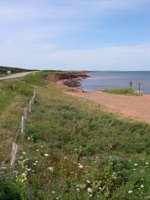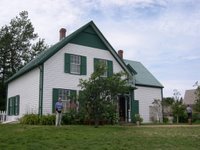Nova Scotia—when planning to come to the Maritime Provinces of Canada, this is what we were looking for: beautiful sea coasts, incredibly blue oceans, hiking trails, cool ocean breezes, wildlife.
We spent several days relaxing near Truro, NS, where we saw the Tidal Bore. That is apparently a common term, but we had never heard it till we came here. It describes a wave of water going upstream in a river when the tide comes in.
 Because the of the shape of the Bay of Fundy, which is between Nova Scotia and the eastern shores of New Brunswick and Maine, the tides are very high—15-20 feet in some places. At Truro, we watched this wave come up and the tide rose somewhere between six and 10 feet in about 30 minutes.
Because the of the shape of the Bay of Fundy, which is between Nova Scotia and the eastern shores of New Brunswick and Maine, the tides are very high—15-20 feet in some places. At Truro, we watched this wave come up and the tide rose somewhere between six and 10 feet in about 30 minutes.We have enjoyed eating locally-grown produce, especially corn on the cob, blueberries and potatoes. Blueberries are always expensive in Colorado, but here in season they are quite reasonable and we have bought them several times. They even sold them in the campground store at Baddeck.
We spent a week at the Cabot Trail Campground in Baddeck on Cape Breton Island, which makes up the northeast part of Nova Scotia. We used it as a base to explore the Cabot Trail. In 1497 John Cabot of England discovered North America as he searched for a route to India. Tradition says he touched land on the northern coast of Cape Breton. Most of the island has a Scottish heritage. We attended a Fiddler Festival where we heard violins and guitars playing Celtic music. The festival was first organized to keep the Cape Breton tradition of
 fiddling alive and they can now bring together 200 fiddlers at one time. There is a Celtic College hear Baddeck where people come from all over to learn Celtic music and crafts and how to speak Gaelic. We have learned a Gaelic word, ceilidh (pronounced kay-lee), which means party or gathering. There are ceilidhs weekly in several communities around Cape Breton.
fiddling alive and they can now bring together 200 fiddlers at one time. There is a Celtic College hear Baddeck where people come from all over to learn Celtic music and crafts and how to speak Gaelic. We have learned a Gaelic word, ceilidh (pronounced kay-lee), which means party or gathering. There are ceilidhs weekly in several communities around Cape Breton.Bras d’Or Lake is a very large body of water in the center of Cape Breton. On the west shore of the lake near Baddeck we visited the Alexander Graham Bell Museum. Bell, who (if you remember your history) invented the telephone while living in New York, built a home on Lake Bras d’Or (pronounced bruh-door and meaning arm of gold in French) and lived and worked there for many years before his death. At the museum we learned a great deal about this amazing American inventor. His wife was deaf and he spent many years working to improve the lives of deaf persons. A hydrofoil boat and an airplane were among his inventions.
The first Europeans to settle here were the French, who built a fortress near the northeast corner of the island to protect from British invasion. Unfortunately, the
 two times the Louisbourg Fortress was attached by the British, it was from the landward side and both times the French were defeated—the last time in 1758. While eating lunch in a restaurant that served 18th century food at the living history restoration of the Louisbourg Fortress, we came to appreciate that we are able to travel the way we do. After ordering our lunch—heavy bread, split pea soup, and grilled cod, two women came in and sat at our table. At that point we had been on the road for 2½ months, 1½ in Canada. They were on a bus tour of the Maritime Provinces that lasted 8 days. They envied our ability to go where we wanted, when we wanted. Soon another couple also sat at our table. They had just completed 10 weeks in Newfoundland and Labrador, places we hadn’t had time to visit. We really connected with them and shared experiences. And the two women from the tour groups didn’t have a clue about our lifestyle. We caught our love of travel from my parents, who always traveled on organized tours. We know they thoroughly enjoyed their travels, but are grateful for our footloose and free way of doing things.
two times the Louisbourg Fortress was attached by the British, it was from the landward side and both times the French were defeated—the last time in 1758. While eating lunch in a restaurant that served 18th century food at the living history restoration of the Louisbourg Fortress, we came to appreciate that we are able to travel the way we do. After ordering our lunch—heavy bread, split pea soup, and grilled cod, two women came in and sat at our table. At that point we had been on the road for 2½ months, 1½ in Canada. They were on a bus tour of the Maritime Provinces that lasted 8 days. They envied our ability to go where we wanted, when we wanted. Soon another couple also sat at our table. They had just completed 10 weeks in Newfoundland and Labrador, places we hadn’t had time to visit. We really connected with them and shared experiences. And the two women from the tour groups didn’t have a clue about our lifestyle. We caught our love of travel from my parents, who always traveled on organized tours. We know they thoroughly enjoyed their travels, but are grateful for our footloose and free way of doing things.The coast of the island is dotted with isolated fishing villages, such as St. Margaret on the northern tip, and attractive harbors, like Pleasant Bay. After Baddeck we spent five nights in a campground in the Cape Breton Highlands
 National Park. The northern portion of the island has several mountains rising over 1200 feet from sea level, which reminded the Scottish settlers of the homeland. The scenery is spectacular and the wildlife wonderful. As we have driven across Canada, we have seen many signs warning us to be careful of the moose, but it wasn’t until Cape Breton that we actually saw them—11 in two
National Park. The northern portion of the island has several mountains rising over 1200 feet from sea level, which reminded the Scottish settlers of the homeland. The scenery is spectacular and the wildlife wonderful. As we have driven across Canada, we have seen many signs warning us to be careful of the moose, but it wasn’t until Cape Breton that we actually saw them—11 in two  days, plus four black bear. What a treat! Most of the sightings were early in the morning and we didn’t get good photos, but a few came out.
days, plus four black bear. What a treat! Most of the sightings were early in the morning and we didn’t get good photos, but a few came out.We have been able to make several hikes in Nova Scotia, mainly on Cape Breton. We often feel we could be hiking in the Colorado mountains, with hills, rocks, roots in the path and evergreen trees. But then we see the many different mushrooms and ferns and see the blue, blue ocean and hear the ocean waves crashing below and we know we aren’t in Colorado. This is a country with lots of moisture and therefore, lots of green. The mushrooms were especially prevalent and diverse as we hiked at Thomas Cove near the Bay of Fundy in early August.
 The Skyline Trail in Cape Breton Highlands National Park gave us views of moose, as well as a boardwalk over an open headland with a magnificent view of the ocean and nearby Cheticamp, a small fishing and tourist community just outside the park.
The Skyline Trail in Cape Breton Highlands National Park gave us views of moose, as well as a boardwalk over an open headland with a magnificent view of the ocean and nearby Cheticamp, a small fishing and tourist community just outside the park.We are ending our time in Nova Scotia with a week on the southern shore of the country.
 Peggy’s Cove has a much photographed lighthouse on St. Margaret Bay near Halifax, the capital city of Nova Scotia. Our RV park overlooks the bay, which is beautiful.
Peggy’s Cove has a much photographed lighthouse on St. Margaret Bay near Halifax, the capital city of Nova Scotia. Our RV park overlooks the bay, which is beautiful.Most of our travels in Canada have taken us to RV parks used almost exclusively by Canadians—either people on holiday or people who park their trailers there for the season and spend every weekend there. We are hearing that tourism is down considerably, in part at least due to high gas prices. Since coming to Nova Scotia we encountered tourists from the US, almost for the first time. It is interesting to see how we gravitate toward one another and share our experiences. We haven’t found most Canadians terrible friendly.
We also are learning about gas price regulation, which New Brunswick, Prince Edward Island and Nova Scotia have implemented this year. A month ago, we were paying $1.23 a liter for gas—that translates to $4.67 a gallon. By August 31, the price in Nova Scotia was down to $1.01 per liter and on the new we heard prices in Ontario were as low as $0.67 per liter. We know prices in the States are high, but not as high as here and we don’t experience such large price swings—56 cents per liter or $2.55 per gallon in two months. Whatever gas costs when we go back to the states, it will be less expensive than here.
On Labor Day we will take a ferry from Yarmouth, NS, to Bar Harbor, Maine, and begin our exploration of New England.








